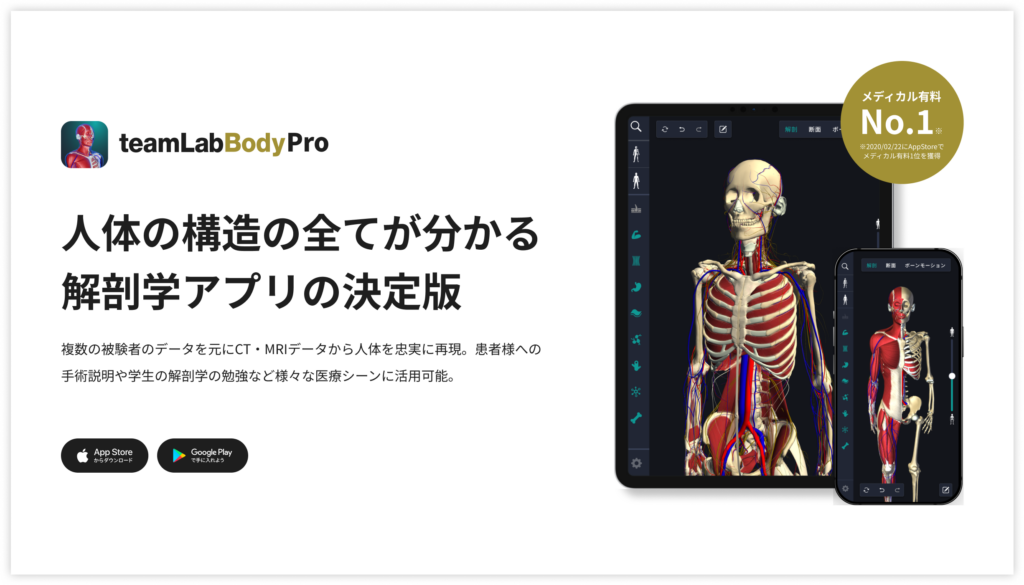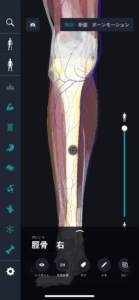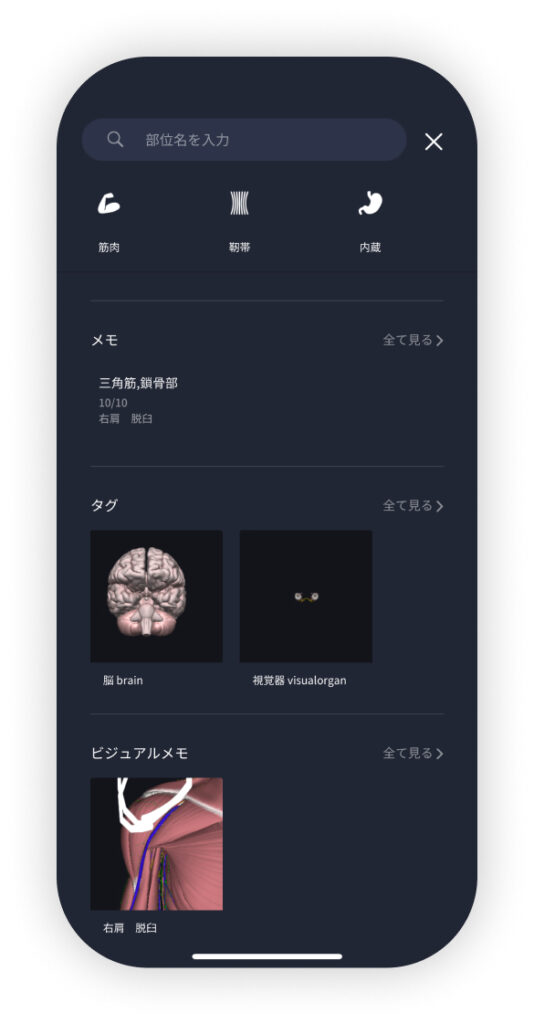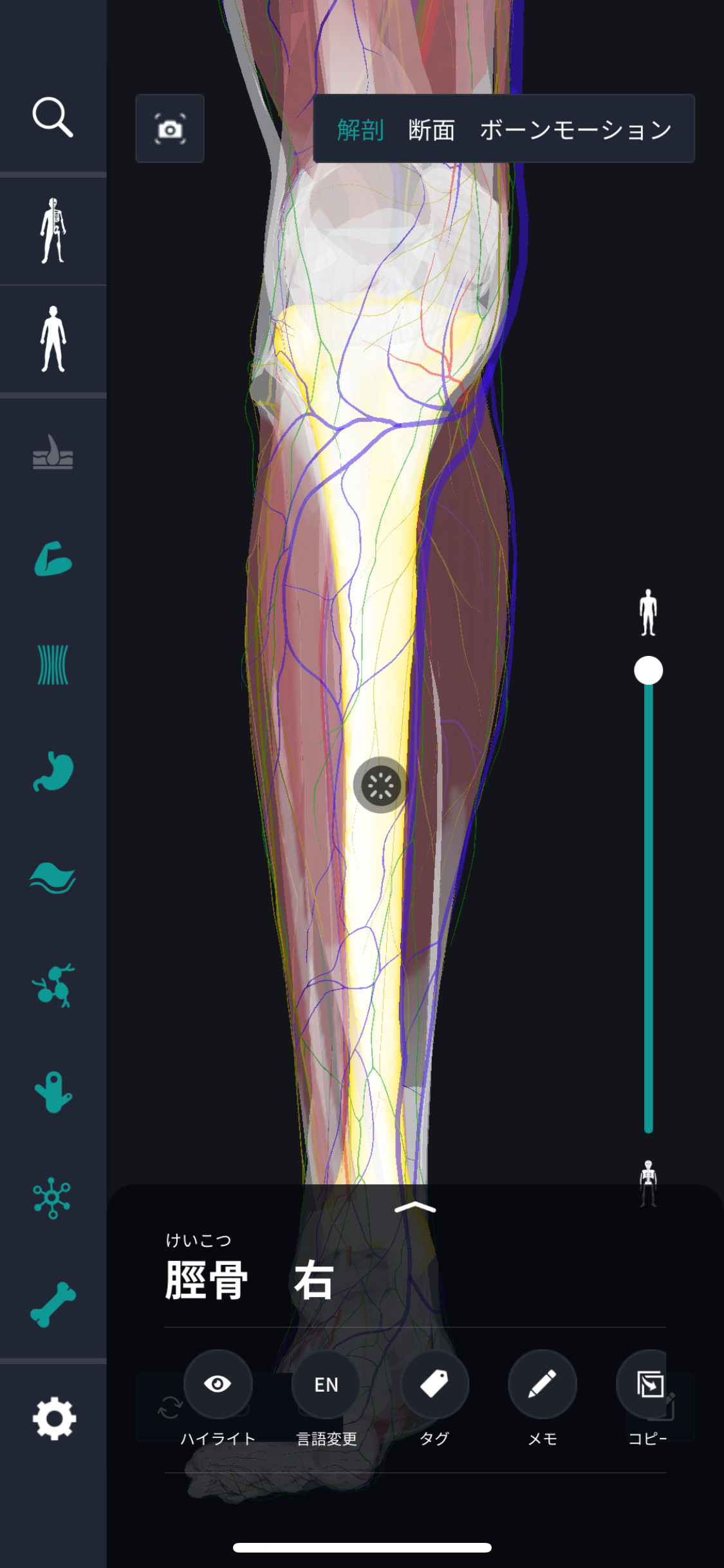beginning
In this article, I will explain effective study methods, starting with knowledge of specialized parts in human anatomy.
In human anatomy, it is necessary not only to memorize the names of various organs, muscles, and bones, but also to remember where they are located in the body. Therefore, it is necessary to learn as efficiently as possible.
I hope you can read this article and use the app to deepen your understanding even a little bit.
Now, I'll explain the details about the “tibia” and how to study human anatomy.
teamLab Body Pro Free Download
A 3D anatomy app that shows all the structures of the human body
Download teamLab Body Pro here!

What is a tibia?
In the anatomy application, you can view a selection of anatomy 3D models. In this model, there are various observation methods such as surfaces, cross-sections, and nervous systems. This time, I'll explain using an anatomy application.
About tibia

The tibia is a foot bone in the human body and is located between the femur, which is the bone of the thigh, and the fibula of the lower leg. The tibia is the second largest of the long bones in the human body, and it plays the most important role in supporting body weight. Its shape is wide at the top and is connected to the knee joint, and the lower part has a rounded structure to form the ankle joint. Since this bone contains bone marrow inside, it is also involved in blood production. The mendial at the upper end of the tibia and the lateral condyle are places where muscles and tendons that help stabilize the knee attach. Also, since it is just below the skin, there are aspects where bruises and fractures are more likely to occur compared to other bones. The tibia plays an important role when walking, running, and standing in everyday life, and is an essential bone for maintaining the body's center of gravity. Since it supports foot function, the tibia is constantly under heavy load, and maintaining a healthy state is very important for the balance and movement of the whole body.
Study points
The location and structure of the tibia
The tibia is the lower leg of the human body and is a bone that plays a very important role in the long bones of the foot. The tibia is located in front of the lower leg, between the femur and fibula, and extends from the knee to the ankle. This bone is the key connecting the knee joint to the fibula of the lower leg, and forms part of the body's main weight support structure. The upper end of the tibia is bulging, and it is a part called the tibial condyle, and ligaments and muscles adhere to it as a component of the knee joint. This part plays an important role in supporting body weight. The entire tibia contains bone marrow inside, which also contributes to blood production. Also, since its surface is covered with relatively thin tissue, it is more sensitive to impact from the outside world than other bones, and is prone to bruising and damage. The area near the ankle forms a joint that enables the foot to move flexibly, and plays a role in supporting the foot and absorbing shock during walking and running.
The role and function of the tibia
The tibia is a bone that plays an important role in the human body, and its main function is to support body weight and help with movement. The tibia is located on the front of the lower leg and extends from the knee to the ankle. As the main long bone that supports weight, it forms a structure that supports the load on the upper body when combined with the femur bone. When walking or running, the tibia forms the ankle joint and acts as the primary axis to enable forward and backward movement of the foot. The tibia also plays an important role in supporting the body's center of gravity and maintains stability when standing. When bending or extending the knee, the tibia smoothly supports leg movement by applying torque through the knee joint. This allows the foot to absorb shock generated during walking or running and maintain foot flexibility. Furthermore, as an attachment point for muscles and ligaments, the tibia enables transmission of force during exercise, and also plays a role in supporting efficient movement. Due to these structural and functional characteristics, the tibia is an essential bone for daily movement.
English notation for tibia
The tibia, called “tibia” in English, is an important component of the skeletal system of the human body and is located in the lower leg. The name “tibia” is a term indicating the characteristics of this bone that is strong and supports weight. It is the second largest bone in the human body and plays an important role in forming the knee and ankle joints. Anatomically, the tibia meets the femur at the top and forms a tibial plateau that allows stability and movement of the knee. The lower part connects to the talus bone and supports the weight of the body while helping with foot flexibility and movement. The anterior edge of the tibia is called the tibial crest, and the upper tibial tubercle is important as an attachment point for muscles and ligaments necessary for knee extension and lower leg movement. The tibia supports the body's bipedal posture, balances weight distribution, and provides effective shock absorption during exercise. Understanding the English notation for tibia and its function is useful for accurate communication and treatment interventions related to fractures and disorders in fields such as orthopedics, physical therapy, and sports medicine.
How to study human anatomy
I will explain specific study methods using human anatomy applications.
Check your past learning history and practice repeatedly
Here are the steps to check your anatomy learning history and practice iteratively effectively.
1. Check your learning history in the app
Reviewing your learning history with the application is an important step in effectively advancing anatomy learning. First, launch the app and go to the learning history section from the main menu. Many anatomy apps are designed to show your progress in the form of graphs and lists, so you can visually check which parts you've learned about and how much time you've spent.
By using this data, you can understand which areas you have strengths in and where you need to spend more time and effort. We also recommend using a dedicated tag or notebook function to mark areas you are particularly weak at or where you need to relearn. Regularly checking your learning history and looking back on past learning content will lead to efficient review and deepening understanding.
2.Make a plan for iterative learning
Making an efficient repetitive learning plan based on learning history is extremely effective in promoting knowledge retention. First, identify weak points and areas where you need to relearn. Next, arrange these study items into a weekly or monthly calendar and create a specific study schedule. By proceeding in a planned manner, you can learn each part evenly and avoid packing in a large amount of information at once.
Using a task management app or digital calendar to set study reminders is effective. Also, it's important to have the flexibility to regularly review progress and revise plans as needed. By having goals and proceeding with your studies in a planned manner, you can efficiently acquire anatomical knowledge.
3.Use 3D features to learn visually
By utilizing the 3D function, learning anatomy is easier to understand visually. The 3D model shows the structure of the human body three-dimensionally, and each part can be observed in detail. This makes it possible to intuitively grasp positional relationships between deep muscles and organs that are difficult to capture in a planar view. For example, you can learn even the smallest details by rotating specific muscles and bones and zooming in and out.
Also, there are many apps that have the function of displaying cross-sectional views of each part using a 3D model, which is useful for deepening understanding of internal structures. This diversity of visual information helps with memory retention and improves immediate responsiveness in tests and practice situations. By utilizing the 3D function and learning visually, you can learn anatomy knowledge more deeply and efficiently.
Use the memo function concretely

Make notes so you don't forget the things and points you've noticed while studying. The memo function can be used for different purposes, such as inputting text, saving images, and writing memos. Tag your notes to make them easier to review later.
Test your learning regularly in the form of quizzes
Regularly testing what you've learned in a quiz format is a very effective way to anchor your anatomy knowledge. Quiz-style tests help you objectively grasp your level of understanding and areas you lack while repeating knowledge.
For example, by using a learning app to conduct quizzes every specific period, you can reconfirm what you've learned and strengthen your memory. There are a wide range of quiz formats, such as multiple choice questions, fill-in-the-blank questions, and short answer questions, and each helps understanding from a different angle and develops the ability to utilize various types of knowledge.
Get feedback
If possible, get feedback from other learners and experts. It helps you find your own gaps in understanding and areas for improvement. You can also keep yourself motivated to learn by regularly testing yourself. Feeling a sense of accomplishment and progress increases motivation for continuous learning.
summary
This time, I explained how to study “tibia” using an application!
Thank you for reading this far.
I would be happy if reading this article helped you learn about anatomy.
Learning is a long, never-ending journey, but I sincerely wish you all the best. Let's continue to study together and work hard for the national exam!
Please look forward to the next blog.




